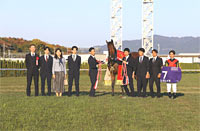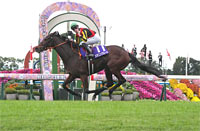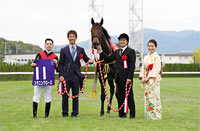Queen Elizabeth II Cup (G1) - Data Analysis
Autumn queen decider that brings a clash between 3-year-old fillies and veteran mares
The Queen Elizabeth II Cup was originally held under the name Victoria Cup. It was renamed Queen Elizabeth II Cup in 1976 to commemorate Queen Elizabeth’s visit to Japan a year earlier. From 1996, the race was opened to older horses, transforming into a clash between 3-year-old fillies and veteran mares that determines the autumn queen. This year’s race will again be held at Hanshin Racecourse as Kyoto Racecourse is undergoing maintenance work. Let’s now look at some trends in this race based on data for the last 10 years.
Highly favored runners prove unreliable
Looking at performances by runners over the last 10 years in terms of favoritism, we find that runners backed as 1st favorite and 2nd favorite each produced one winner and collectively achieved a Top 2 ratio of 25.0%. This suggests that highly favored runners are not reliable. Runners backed as 3rd-5th favorite achieved a higher Win ratio, while runners backed as 6th-10th also put up a decent fight. In 2021, the race was won by 10th favorite Akai Ito, resulting in a massive Trifecta payout of over 3 million yen. When making our predictions, we should therefore not place too much confidence in highly favored runners. [Table 1]
[Table 1] Performance by favoritism (last 10 years)
| Favoritism |
Performance
[1st-2nd-3rd-4th or lower] |
Win ratio |
Top 2 ratio |
Top 3 ratio |
| 2nd favorite or higher |
2-3-3-12 |
10.0% |
25.0% |
40.0% |
| 3rd-5th favorite |
5-1-5-19 |
16.7% |
20.0% |
36.7% |
| 6th-10th favorite |
3-5-2-40 |
6.0% |
16.0% |
20.0% |
| 11th favorite or lower |
0-1-0-72 |
0% |
1.4% |
1.4% |
Focus on three-year-olds and four-year-olds
Looking at performances by age, we observe that three-year-olds and four-year-olds have achieved high success ratios. Runners aged 4 or below have occupied the entire Top 3 in five of the last 10 races. Conversely, runners aged 6 or above have turned in lackluster performance, with only one of the 19 runners in this group finishing in the Top 3 over the last 10 years. This suggests we should lower our expectations of runners aged 6 or above. [Table 2]
[Table 2] Performance by age (last 10 years)
| Age |
Performance
[1st-2nd-3rd-4th or lower] |
Win ratio |
Top 2 ratio |
Top 3 ratio |
| 3 |
2-4-2-27 |
5.7% |
17.1% |
22.9% |
| 4 |
6-3-7-50 |
9.1% |
13.6% |
24.2% |
| 5 |
2-2-1-48 |
3.8% |
7.5% |
9.4% |
| 6 or above |
0-1-0-18 |
0% |
5.3% |
5.3% |
No strong performers among runners that have finished 8th or lower in their previous race
In the last 10 Queen Elizabeth II Cup races, there have been no examples of rebound performances by runners that had finished 8th or lower in their previous race. Even former G1 winners such as race favorite Verxina in 2013 (had won same-year Victoria Mile but finished 8th in the Kyoto Daishoten last time out) and 2nd favorite Meisho Mambo in 2014 (had won three previous G1 races, but finished 10th in the Kyoto Daishoten last time out) were unable to pull off a comeback. [Table 3]
[Table 3] Performance by finish in previous race (last 10 years)
| Finish in previous race |
Performance
[1st-2nd-3rd-4th or lower] |
Win ratio |
Top 2 ratio |
Top 3 ratio |
| 7th or higher |
10-10-10-104 |
7.5% |
14.9% |
22.4% |
| 8th or lower |
0-0-0-39 |
0% |
0% |
0% |
Runners coming from a non-graded race fare poorly
The 10 previous winners had all contested a graded race in their last outing. Conversely, only two runners coming from a non-graded race finished in the Top 3 over the last 10 years: third-place finisher Pixie Princess in 2012, and runner-up Lachesis in 2013. In the subsequent eight years, runners that had contested a non-graded race in their previous race consistently finished outside the Top 3, so we should lower our expectations of runners coming from allowance-class or open-class races. [Table 4]
[Table 4] Performance by previous race (last 10 years)
| Previous race |
Performance
[1st-2nd-3rd-4th or lower] |
Win ratio |
Top 2 ratio |
Top 3 ratio |
| Graded race |
10-9-9-99 |
7.9% |
15.0% |
22.0% |
| Non-graded race |
0-1-1-44 |
0% |
2.2% |
4.3% |
In addition, if we analyze performances by previous race among runners that had previously contested a graded race, we note that runners coming from the Fuchu Himba Stakes produced 13 Top 3 finishers, including five winners. Runners coming from the Shuka Sho or All Comers similarly produced multiple Top 2 finishers. In other words, we should focus on runners coming from these three races. Other runners that finished in the Top 3 have come from graded races in the summer, or from G1 races in the spring season following an intervening rest period. Runners coming from the Kyoto Daishoten stand out by virtue of their poor performance, with none of the 13 runners in this group making it into the Top 3. [Table 5]
[Table 5] Among runners that had previously contested a graded race, performance by major previous race (last 10 years)
| Previous race |
Performance
[1st-2nd-3rd-4th or lower] |
Win ratio |
Top 2 ratio |
Top 3 ratio |
| Fuchu Himba Stakes |
5-5-3-42 |
9.1% |
18.2% |
23.6% |
| Shuka Sho |
2-3-1-22 |
7.1% |
17.9% |
21.4% |
| All Comers |
2-1-0-9 |
16.7% |
25.0% |
25.0% |
| Sapporo Kinen |
1-0-1-1 |
33.3% |
33.3% |
66.7% |
| Takarazuka Kinen |
0-0-1-2 |
0% |
0% |
33.3% |
| Niigata Kinen |
0-0-1-2 |
0% |
0% |
33.3% |
Yushun Himba
(Japanese Oaks) |
0-0-1-1 |
0% |
0% |
50.0% |
| Victoria Mile |
0-0-1-0 |
0% |
0% |
100% |
| Kyoto Daishoten |
0-0-0-13 |
0% |
0% |
0% |
Seek out the winner!
Watch runners with experience of finishing in the Top 2 of a G1 race
Eight of the last 10 winners had experience of contesting a G1 race, and seven of these had experience of finishing in the Top 2 of a G1 race. While it is hard to identify win contenders in the Queen Elizabeth II Cup because historical results have been mixed, a Top 2 finish in a previous G1 race appears to be a good selection criterion. [Table 6]
[Table 6] Winners’ experience of finishing in Top 2 of major G1 race (last 10 years)
| Year |
Winner |
Experience of finishing in Top 2 of G1 race |
| 2012 |
Rainbow Dahlia |
No such Top 2 finish |
| 2013 |
Meisho Mambo |
Yushun Himba (Japanese Oaks), 1st |
| 2014 |
Lachesis |
Queen Elizabeth II Cup, 2nd |
| 2015 |
Marialite |
No previous G1 entry |
| 2016 |
Queens Ring |
Shuka Sho, 2nd |
| 2017 |
Mozu Katchan |
Yushun Himba (Japanese Oaks), 2nd |
| 2018 |
Lys Gracieux |
Victoria Mile, 2nd |
| 2019 |
Lucky Lilac |
Hanshin Juvenile Fillies, 1st |
| 2020 |
Lucky Lilac |
Osaka Hai, 1st |
| 2021 |
Akai Ito |
No previous G1 entry |
(Yodohito Himezono)
|



















